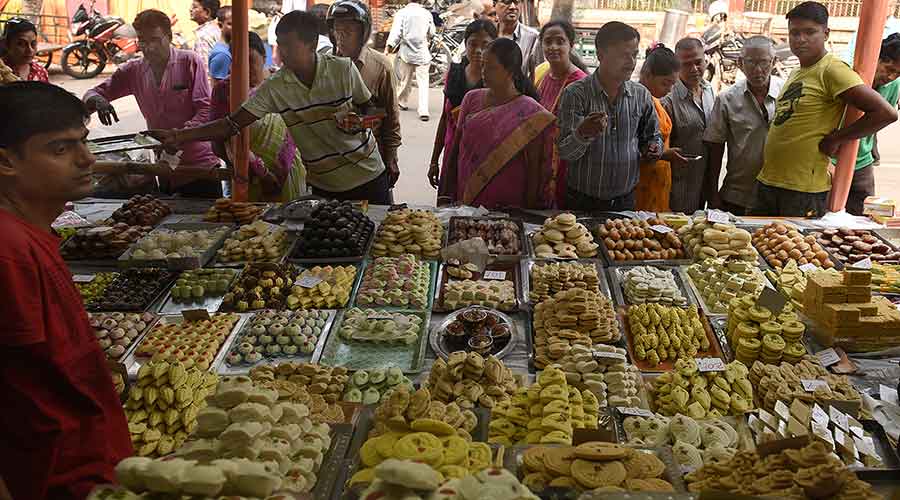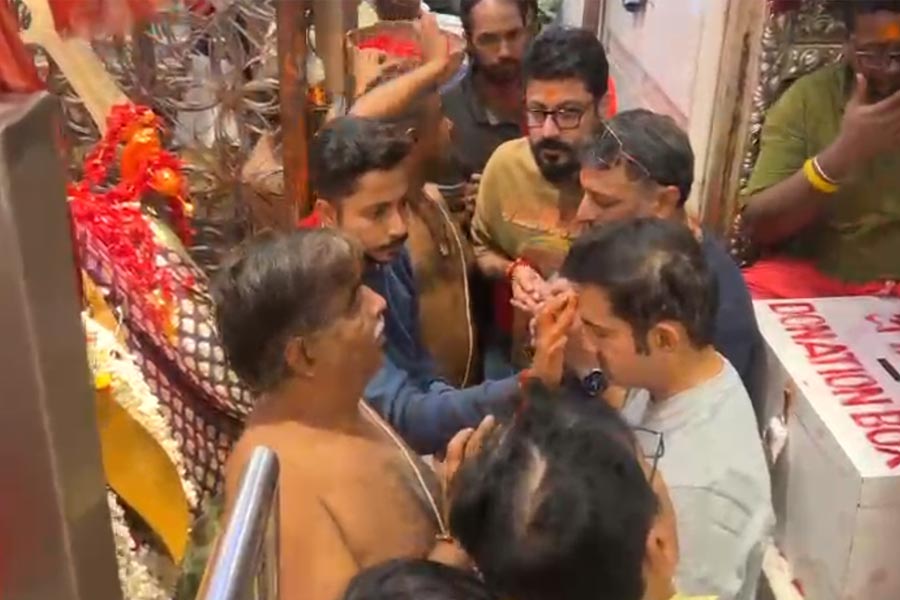I was born in 1946, in Calcutta, when the pre-Partition riots were raging. But I wasn’t a Calcuttan. My father’s family was from a small village in Khulna, not really displaced by Partition for they had chosen to disperse all over India for their livelihood. My father was an air force officer in the short service commission and got demobbed shortly before I was born. My mother’s side, originally from Sonarang in Dhaka district and Barisal was settled in Calcutta and Santiniketan. My father’s post-war occupation took him to a small company town in Hooghly. So I grew up, mostly in Hooghly, but had more than mere glimpses of Calcutta and Santiniketan.
My hometown in Hooghly didn’t have any iconic sweets. My father would take us for long drives in his Landmaster, some of these expeditions were with the sole purpose of tasting some sweet or the other. One such was Khanyan’s rajbhog. Rajbhogs are large rasagollas with a hollow centre; in Calcutta and other places they would insert into it a nakuldana, but the moiras of Khanyan would plug the hollow with an orb of ksheer.
In the Katwa line, there is a place called Somrabajar, there they would sell something called the gooposandesh, it was made of chhena but had the texture of soan papri. Chandernagore was already known for the Surya Modak confections such as sarbhaja and malai chamcham. On the other side of River Hooghly was Halisahar known for its Vaishnava malpua while Naihati was known for its naram paker sandesh. There are two broad varieties of the sandesh — naram pak or soft and kara pak or hard.
In Calcutta, rasagollas were the rage, as it was everywhere in Bengal. When I was about three-and-a-half years old, I was down with jaundice. It robbed me of a full year of school and fun. My grandfather didn’t allow me anything that was not homecooked. The only concession was the rasagolla, purchased from the shop and given to me after being thoroughly boiled in water. Needless to say, that ended my honeymoon with Bengal’s most hyped sweet forever.
The sweets of Bengal that were popular in my childhood days were imaginatively named — pranahara meaning life claiming, abar khabo, meaning give me more, and kothay pabo, meaning where shall I find it.
My father had spent a part of his childhood in Nasipur in Murshidabad. He was very fond of Nasipur’s chhenabaras and I remember him getting potfuls whenever he visited the place. Rasagollas are porous orbs of chhena. Gulab jamuns have a similar core but the fried skin is dark and harder. Chhenabaras have the same type of fried skin but the core is chewy.
One variant of the chhenabara was called topa kul. It was not as brown and its fried skin was slightly loose. The small dimpled balls looked like the ripe berries of the plum. I tasted this version in a Berhampore sweet shop called Khabar Dabar and liked it a lot. Today the chhenabara survives mostly in Bengali idiom, a reference to the wide-eyed look.
After one of our routine Santiniketan visits, my father drove us past the Masanjore Lake to Dumka, where one of his distant cousins lived. There, I had my only taste ever of a preparation called ksheer khejur, a not-too-runny pudding of dried, deseeded dates in evaporated milk. It was heavenly but never sold by established confectioners anywhere in Calcutta.
Khoya sweets were once upon a time readily available at all confectioners’ outlets. No, I’ve never had ksheerer putul, except in the book form. (For those who are not familiar with the reference, I should add that it is the name of Abanindranath Tagore’s children’s fantasy novel which has a doll of evaporated milk as the protagonist.) But a genre of sweets called ksheerer chhanch was freely available in the late 1940s and early 1950s.
A chhanch is a wooden or terracotta mould with designs carved on them. Chhena sandesh, when pressed into such a mould, comes out with faithfully reproduced impressions of ata or wood apple or fish sandesh. Ksheer, alas, isn’t faithfully mouldable. The ahladi putul (pampered doll) sandesh available at a shop in Gariahat was a faceless/featureless blob, but delectable nevertheless. The moulded canines sold at Lakshmi-Narayan Mishtanna Bhandar at Rashbehari Crossing were horse-sized and even better for they were larger than the dolls.
The Calcutta I was then most familiar with was the Gariahat area of Rashbehari Avenue. Within 100 metres on either side of our apartment, there were more confectioners than you’d care to think.
There were no more than three or four varieties on display and among the specials were aadhkhana, which looked like a boiled egg cut in half; the flat poach sandesh; a light green thing called honey dew and danadar, which was a variant of the rasagolla with a sprinkling of sugar on its hard fried coating. In the 1950s, the large-sized rassgollas came for one anna.
My grandfather’s apartment never fell short of the best sweets. Not merely because of locational advantage but because he was a medical doctor who treated most of his patients for free. Though our ancestral land was taken, sweets from across the border would come in through visiting relatives and former patients.
Of all the Bangla sweets, I was partial to the patksheer of Tongi and Porabarir chamcham — both Tongi and Porabari are in Bangladesh now. Patksheer was set either in banana leaves or in shallow terracotta dishes known as malsa. West Bengal confectioners never came to grips with such esoteric sweets. Natore, now in Jessore, was famous for its essentially amorphous kanchagolla, sold by the weight.
For Vijaya Dashami snacks, I liked to go to the Sen Roy household in Hooghly. The family, displaced from Dhaka, had retained many culinary delights in their array of expertise. Mr Sen Roy’s sister, Pushpa (universally referred to as PawPaw), who was a schoolteacher, made lovely jeere chire and padmachinir chak.
To prepare jeere chire, you have to grate the coconut. Then dry the flakes in gentle heat with continuous fanning, and thereafter dip them in a light lotus-scented sugar syrup repeatedly. Between each dip, they have to be dried out till they are free-flowing. The end product had to be of the shape and size of chire which is dried, flattened parboiled rice and should melt in your mouth.
Another version of the same stuff was ichamuda which resembled a fried lobster head. Both sweets required immense labour and skill, but the end result was out of the world. The main material for padmachinir chak was the core of the lotus flower. It had to be cut out from freshly plucked flowers in one piece, dipped in thick sugar syrup and dried. PawPaw often scented her padmachinir chak with saffron.
No account of the sweets of Bengal would be complete without a mention of lal doi from Mollar Chawk. It was much thicker than Jalajoga’s payodhi and usually sold by itinerant vendors irregularly in Calcutta nooks; they carried them in terracotta pots hung from a shaft.
Nobody knows how such wonders have been allowed to vanish through negligence. It is the same for the sweetness of Bengal.













